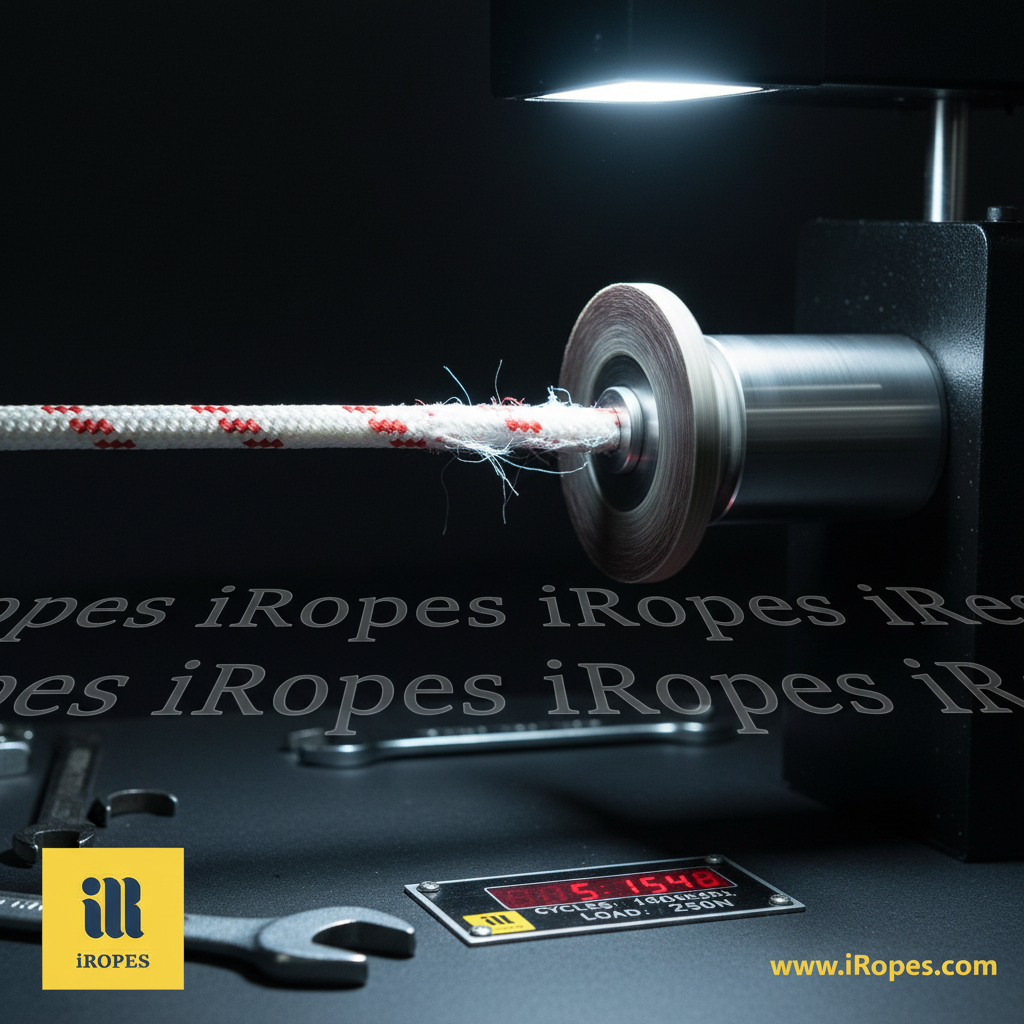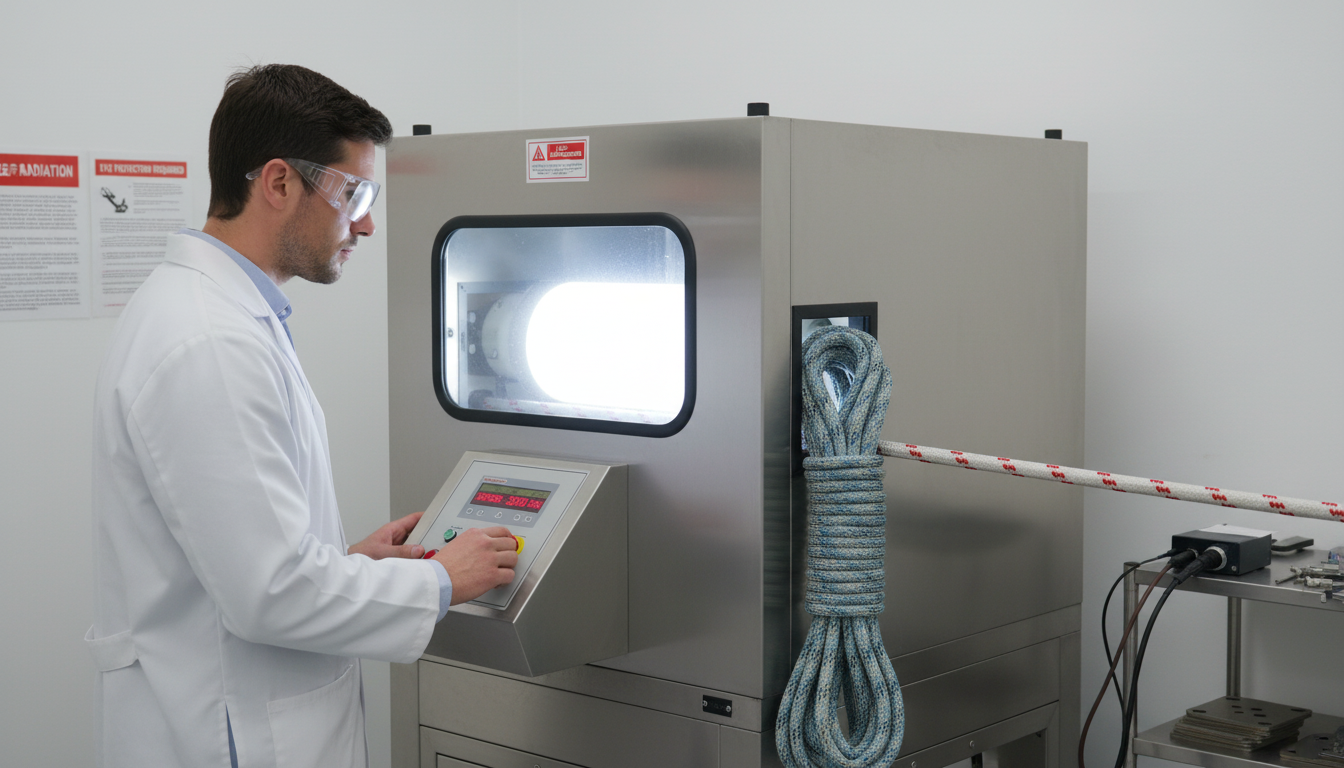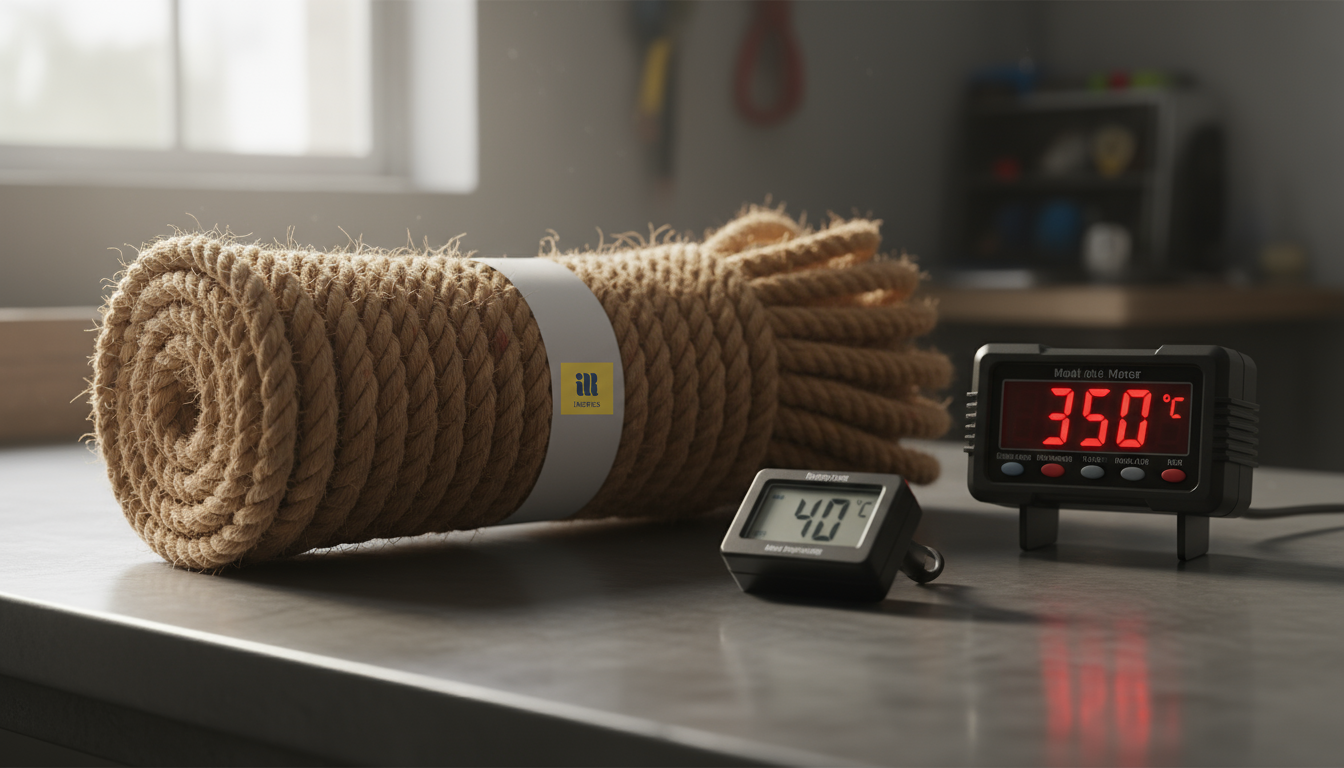iRopes’ Ultra‑Guard Dyneema line records ≤ 1 % abrasion loss after 10 000 cycles (ISO 4649) — delivering the most abrasion resistant rope for demanding jobs. For UV performance, our Polyester UV‑Shield retains ≥ 95 % tensile strength after 1 000 h (ASTM G154). As a leading rope maker in China, we engineer both solutions for wholesale partners.
Quick guide: How you’ll out‑perform wear, UV and heat
- ✓ Cut rope‑replacement cost by specifying ≤ 1 % abrasion‑loss Dyneema constructions.
- ✓ Preserve ≥ 95 % load capacity after 1 000 h of sun exposure with polyester UV‑Shield.
- ✓ Operate safely up to 40 °C continuous and tolerate 377 °C spikes with heat‑treated Manila.
- ✓ Access ISO‑9001‑certified OEM/ODM customisation with fast, punctual turnaround.
Many rigs still rely on standard nylon that wears quickly under repeated contact, whereas a Dyneema‑based line can keep wear under 1 % after ten thousand cycles. Pairing the right fibre with iRopes’ low‑friction coating and UV‑inhibitor extends service life and improves long‑term load retention in sun‑baked environments. Keep reading to see how to combine abrasion, UV and heat performance into a rope that quietly outlasts harsh conditions.
Understanding the most abrasion resistant rope
Having explored why overall rope durability matters, it’s time to focus on the wear‑and‑tear factor that can make or break a rigging system: abrasion resistance. When a rope repeatedly slides over rough surfaces or sharp edges, its fibres gradually lose material, reducing strength and safety.
What abrasion resistance really means
In technical terms, abrasion resistance is the ability of a rope to retain tensile strength after standardised rubbing cycles. While ISO 4649 is a recognised abrasion test for materials, rope makers use equivalent cyclic‑abrasion rigs and report percentage loss. A low loss percentage means the rope can endure harsh environments—think off‑road rigs, arbor work, or heavy‑duty industrial lifts—without frequent replacement.

How the fibres stack up
The material you choose determines how well the rope survives cyclic abrasion. Below is the performance hierarchy, with the top spot answering the common query “What is the most abrasion‑resistant rope?”:
- Dyneema (UHMWPE) - ≤ 1 % abrasion loss after 10 k cycles (ISO 4649‑style testing)
- Nylon - 4‑5 % loss under the same test conditions
- Polyester - moderate wear, higher than nylon but better than Manila
- Manila - natural fibre with higher abrasion loss than common synthetics
- Polypropylene - highest wear; unsuitable where durability is critical
Dyneema’s ultra‑high molecular weight polymer aligns its chains into tightly packed crystals, giving it surface toughness that outperforms traditional nylon or polyester. That’s why the most abrasion resistant rope for demanding applications is a Dyneema‑based construction.
iRopes’ proprietary solution
At iRopes, we have taken Dyneema’s advantage a step further. Dyneema ultra‑high molecular weight rope offers the same ≤ 1 % wear rate while enabling custom diameters, colour‑coding and brand‑specific terminations. Produced in our ISO 9001‑certified facility in China, OEM and ODM partners receive a product built to exact load calculations, protected by end‑to‑end IP safeguards, and shipped on time.
“The ultra‑high molecular weight of UHMWPE aligns the polymer chains, giving Dyneema its exceptional wear resistance compared with conventional nylon.” – Dr. Lena Wu, Materials Engineer
When you pair that material advantage with iRopes’ flexible OEM/ODM program, you get a rope that not only survives the toughest abrasion cycles but also fits your brand’s visual language and engineering specs. Now that you understand how abrasion performance is measured, let’s see why UV exposure can change the picture.
Why the most UV resistant rope matters
UV radiation is the silent enemy that can turn a high‑performance line into a brittle hazard in just a few months. Sunlight’s ultraviolet photons break polymer bonds, prompting micro‑cracks that erode strength long before any visible fading appears.

Understanding how UV degrades a rope helps you pick the right material before the damage becomes irreversible. The industry‑standard ASTM G154 protocol subjects samples to an intense UV‑lamp cycle while measuring residual strength at set intervals. The results are clear: polyester emerges as the most UV‑resistant rope, holding at least 95 % of its original tensile capacity after 1 000 h of continuous exposure.
- Photon attack – breaks molecular bonds
- Surface cracking – creates micro‑fissures
- Strength loss – reduces tensile capacity
When you pair polyester’s inherent UV stability with iRopes’ UV‑inhibitor coating, the rope’s lifespan extends dramatically. The coating forms a protective skin that reflects harmful wavelengths while allowing the fibre to breathe — a combination that is especially valuable for marine decks, construction hoists and long‑run outdoor installations.
Polyester ropes keep at least 95 % of their original strength after 1 000 h of continuous UV exposure (ASTM G154), making them the most UV‑resistant choice for outdoor rigs.
Choosing the most UV‑resistant rope isn’t just about longevity; it’s a safety decision. A line that loses strength unnoticed can lead to unexpected failures under load, endangering personnel and equipment. By specifying polyester with iRopes’ UV‑inhibitor treatment, you secure a rope that maintains performance even under relentless sun.
Now that UV performance has been clarified, let’s turn to heat tolerance. Manila rope’s natural flame‑char characteristics offer a surprising advantage in high‑temperature environments, a topic we’ll explore next.
Exploring manila rope heat resistant properties
After examining how ultraviolet light chips away at polymers, the next challenge for many outdoor and industrial rigs is temperature. When a rope sits beside a furnace, a hot‑work welding station or a sun‑baked deck, it must keep its strength without melting or excessive softening. Manila rope, made from natural abaca fibres, offers a robust answer to that problem.
Burn point and everyday heat performance
Manila’s char point sits at roughly 711 °F (377 °C). Below that threshold the fibres darken rather than melt. In routine service the rope can handle continuous ambient temperatures of up to 40 °C (104 °F) without measurable loss of tensile capacity. Short‑duration spikes of 150 °C (302 °F) are also tolerated, making the material suitable for environments where occasional heat bursts occur.
In plain language, if you ask “What temperature can Manila rope withstand?” the answer is: it will not melt until it reaches about 377 °C, and it stays fully strong at typical hot‑work temperatures under 40 °C for prolonged periods.
How Manila compares with common synthetics
Synthetic ropes each have a melt point that defines their upper thermal limit. Polypropylene begins to soften around 165 °C (330 °F) and will flow well before reaching Manila’s char point. Nylon softens near 260 °C (500 °F), while Dyneema (UHMWPE) retains integrity up to about 425 °C (800 °F). The key distinction is that Manila does not melt; it chars and retains structural integrity longer than polypropylene and offers a more gradual strength decline than nylon when exposed to heat.
iRopes’ heat‑treated Manila solution
iRopes enhances the native heat tolerance of Manila with a proprietary heat‑treatment process. The treatment stabilises the fibre surface, reduces moisture uptake and adds a heat‑resistant finish that delays charring. The result is a rope that can be specified for furnace hoists, high‑temperature cable trays and outdoor rigging where ambient temperatures routinely exceed 30 °C.
Customers switching from standard polypropylene to iRopes’ heat‑treated Manila report a measurable reduction in replacement cycles, as the rope resists softening and maintains load‑bearing capacity under intermittent heat exposure.

Heat‑Treated Manila
iRopes applies a specialised thermal‑stabilisation coating to natural Manila rope, giving it a reliable service temperature of 40 °C continuous and resistance to short‑term spikes up to 150 °C. The solution is ideal for furnace hoists, hot‑work cable trays and any application where synthetic melt points become a liability.
With the heat‑resistance profile now clear, the next step is to see how iRopes blends these attributes—abrasion, UV and thermal performance—into fully custom rope systems that meet the exact demands of diverse industries, including applications highlighted in our Manila rope heat‑resistant guide.
iRopes custom solutions and buying guide
Having seen how Manila rope handles heat, you’ll now want a line‑up that blends abrasion, UV and thermal performance into one seamless supply chain. As a leading rope maker in China, iRopes makes that possible through a fully integrated OEM/ODM platform, backed by ISO 9001 certification and end‑to‑end IP protection.

OEM / ODM Excellence
Why partners trust iRopes
ISO 9001 Certified
Our quality system guarantees repeatable performance and full traceability for every batch.
IP Protection
Your proprietary designs stay confidential from concept through delivery.
Fast Turnaround
Custom orders ship promptly, often within weeks, helping you lower inventory risk.
Signature Rope Solutions
High‑performance lines you can specify
Ultra‑Guard Dyneema
Most abrasion resistant rope – ≤ 1 % wear after 10 k ISO 4649 cycles.
Polyester UV‑Shield
Most UV resistant rope – retains ≥ 95 % strength after 1 000 h exposure (ASTM G154).
Heat‑Treated Manila
Manila rope heat resistant, stable up to 40 °C continuous, char point 377 °C.
Choosing the right line is easier when you follow a simple flow: first, calculate the maximum load and add a safety factor; second, match the environment to a material (abrasion, UV or heat); third, decide the optimal diameter for handling and packaging; finally, use our online form to upload the load chart and receive a bespoke quote promptly. Our engineering team will verify compliance with the relevant standards — ISO 4649 for abrasion, ASTM G154 for UV and applicable thermal‑performance standards — before the sample is cut.
Download Spec‑Sheet
Get the full technical matrix, compliance certificates and a ready‑to‑send custom‑quote template for your project.
Ready for a tailored rope solution?
If you need personalised advice on applying the insights from this guide, simply fill out the form above and our engineers will help you choose the right product.
We’ve shown that Dyneema‑based constructions deliver the most abrasion resistant rope, as detailed in our guide to maximizing rope strength, while polyester with a UV‑inhibitor coating is the most UV resistant rope for sun‑exposed rigs. For high‑temperature work, a heat‑treated Manila option provides a Manila rope heat resistant performance up to 40 °C continuous use. Leveraging iRopes’ ISO‑9001 certified OEM/ODM capabilities, you can combine these attributes into a single, custom‑designed line that meets your exact load, environment and branding requirements.